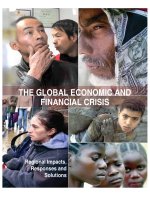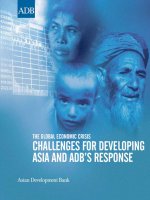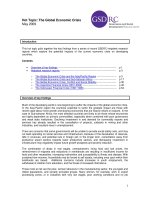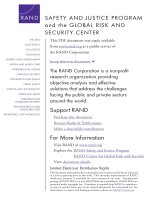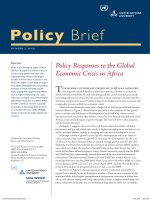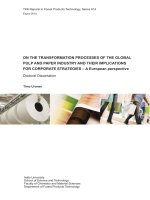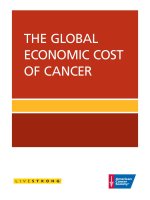un - the global economic and financial crisis, regional impacts, responses and solutions (2009)
Bạn đang xem bản rút gọn của tài liệu. Xem và tải ngay bản đầy đủ của tài liệu tại đây (1.01 MB, 103 trang )
ECONOMIC AND SOCIAL COMMISSION FOR ASIA AND THE PACIFIC
THE GLOBAL ECONOMIC AND
FINANCIAL CRISIS
Regional Impacts,
Responses and
Solutions
THE GLOBAL ECONOMIC AND FINANCIAL CRISIS REGIONAL IMPACTS RESPONSES AND SOLUTIONS
i
The Global Economic and Financial Crisis:
Regional Impacts, Responses and Solutions
New York, 2009
ii
The designations employed and the presentation of the material in this publication do not
imply the expression of any opinion whatsoever on the part of the Secretariat of the United
Nations concerning the legal status of any country, territory, city or area or of its authorities,
or concerning the delimitation of its frontiers or boundaries.
This publication has been issued without formal editing.
Mention of firm names and commercial products does not imply the endorsement of the
United Nations.
Reproduction and dissemination of material in this publication for educational or other non-
commercial purposes are authorized without prior written permission from the copyright
holder, provided that the source is fully acknowledged.
Reproduction of material in this publication for sale or other commercial purposes,
including publicity and advertising, is prohibited without the written permission of the
copyright holder. Applications for such permission, with a statement of purpose and extent
of the reproduction, should be addressed to the Regional Commissions New York Office.
United Nations publication
Sales No. E.09.II.F.18
Copyright United Nations 2009
ISBN:
978-92-1-120585-5
©
iii
The report is a joint product of the five United Nations Regional Commissions (Economic
Commission for Africa (ECA), Economic Commission for Europe (ECE), Economic Com-
mission for Latin America and the Caribbean (ECLAC), Economic and Social Commission
for Asia and the Pacific (ESCAP) and Economic and Social Commission for Western Asia
(ESCWA)).
The report was prepared under the overall coordination and direction of Noeleen Heyzer,
Executive Secretary of ESCAP and Current Coordinator of the Regional Commissions,
assisted by Shigeru Mochida, Deputy Executive Secretary and Officer-in-Charge of the
Macroeconomic Policy and Development Division of ESCAP and Tiziana Bonapace, Chief
of the Macroeconomic Policy and Analysis Section. Amr Nour, Officer-in-Charge, Regional
Commissions New York Office coordinated the preparations and the contributions of the
Regional Commissions to the publication.
At ECA the team consisted of Patrick N. Osakwe and Ben Idrissa Ouedraogo; at ECE:
Robert Shelburne; at ECLAC: Daniel Titelman, Cecilia Vera and Pablo Carvallo; at ESCAP:
Shuvojit Banerjee, Yejin Ha, Somchai Congtavinsutti, Amornrut Supornsinchai and Woranut
Sompitayanurak; at ESCWA: Khaled Hussein and George Harab.
The manuscript was edited by Peter Stalker, the layout and printing were provided by TR
Enterprise, and Marie Ange Sylvain-Holmgren contributed to the design of the cover page.
For further information, please see or contact:
ECA:
Mr. Abdoulie Janneh, Executive Secretary, United Nations Economic Commission for Africa,
P.O. Box 3005, Addis Ababa, Ethiopia, phone: +251-11-5443336; e-mail: ecainfo
@uneca.org.
ECE:
Mr. Jan Kubis, Executive Secretary, United Nations Economic Commission for Europe,
CH-1211 Geneva 10, Switzerland; phone: +41-22-9171234; e-mail:
ECLAC:
Ms. Alicia Barcena, Executive Secretary, United Nations Economic Commission for Latin
America and the Caribbean, Av. Dag Hammarskjold 3477, Vitacura, Santiago, Chile; phone:
+56-2-2102000; e-mail:
ACKNOWLEDGEMENTS
iv
ESCAP:
Ms. Noeleen Heyzer, Executive Secretary, United Nations Economic and Social Commission
for Asia and the Pacific, The United Nations Building, Rajadamnern Nok Avenue, Bangkok
10200, Thailand; phone: +66-2-2881234; e-mail:
ESCWA:
Mr. Bader Al-Dafa, Executive Secretary, United Nations Economic and Social Commission
for Western Asia, P.O. Box 11-8575, Riad el-Solh Square, Beirut, Lebanon; phone: +961-1-
981301; e-mail: />ACKNOWLEDGEMENTS (continued)
v
CONTENTS
Page
Acknowledgements iii
Acronyms x
Overview 1
A crisis across the regions 1
All regions have suffered declines in growth 1
Despite banking sector rescue plans, risks remain 3
Falling equity prices 3
Capital flows have been drying up 3
Sharp falls in commodity prices 5
Contracting global trade 5
Rising protectionism 6
Rising unemployment, increasing poverty 6
Expansionary monetary and banking policies 8
Combating recession with fiscal stimulus 8
An uncertain economic outlook 9
Regional responses for early recovery 9
Regional financial cooperation 9
Efforts at regional coordination 10
The way forward: the role of regional policy-making 10
CHAPTER I 15
The Economic Commission for Africa 15
The impact of the crisis 15
Country policy responses 22
Regional responses 24
The way forward 25
CHAPTER II 29
The Economic Commission for Europe 29
The impact of the crisis 30
Country policy responses 36
Regional responses 40
The way forward 42
vi
CONTENTS (continued)
Page
CHAPTER III 45
The Economic Commission for Latin America and the Caribbean 45
Impact of the crisis 45
Country policy responses 50
Regional responses 50
The way forward 52
CHAPTER IV 57
The Economic and Social Commission for Asia and the Pacific 57
The impact of the crisis 58
Country-specific responses 64
Regional responses 66
The way forward 67
CHAPTER V 73
The Economic and Social Commission for Western Asia 73
The impact of the crisis 73
Country-specific responses 78
Regional responses 80
The way forward 82
References 85
vii
FIGURES
Page
Figure 1 – Real GDP growth by region, 2009 2
Figure 2 – Regional emerging markets equity indices, 19 September 2008-
16 April 2009 4
Figure 3 – Net private capital flows to developing country regions,
2002 and 2007 4
Figure 4 – Total trade as a percentage of GDP (constant 2000 prices) 6
Figure I-1 – Price indices of major commodity groups, 2007-2009 18
Figure I-2 – Remittance inflows to Sub-Saharan Africa ($ billions),
2000-2008 19
Figure I-3 – Unemployment rates in Sub-Saharan Africa, 2003-2008 21
Figure II-1 – Real growth in the major ECE subregions, 1999-2010 31
Figure III-1 – Countries in Latin America and the Caribbean, estimated
growth in 2009 46
Figure III-2 – Latin America, monthly exchange rates in six countries,
2008-2009 46
Figure III-3 – Increases in public expenditure, percentage of 2008 GDP 47
Figure III-4 – Current account balance, percentage of GDP at current prices,
1994-2008 48
Figure III-5 – ECLAC region, commodity price index, 2008-2009 49
Figure III-6 – Measures implemented by ECLAC countries 51
Figure III-7 – Benchmark interest rates, 2007-2009 52
Figure III-8 – ECLAC region – GDP growth and net capital flows as a
percentage of GDP 54
Figure IV-1 – Stock of portfolio investments as a percentage of foreign exchange
reserves, selected economies, 2001 and 2008 or latest 58
Figure IV-2 – Current account balances as a percentage of GDP, selected
developing ESCAP economies, 1996 and 2008 59
Figure IV-3 – Short-term debt as a percentage of GDP, selected developing
ESCAP economies, 1996 and 2007 60
viii
Page
Figure IV-4 – Equity market decline from peak to trough in 1997/98, and in the
current crisis from peak to end-March 2009 61
Figure IV-5 – Selected stimulus packages as a percentage of GDP 65
Figure IV-6 – Fiscal balance, top surplus and deficit economies, 2008 66
Figure IV-7 – Economic growth, selected ESCAP economies, 2007-2009 68
Figure IV-8 – Real GDP growth, selected developing ESCAP and developed
economies, 2003-2009 69
FIGURES (continued)
ix
Page
Table I-1 – Expected exchange rate depreciation in Africa against the
US dollar, 2009 17
Table I-2 – Africa’s merchandise trade, annual percentage change at constant
prices, 2006-2008 19
Table I-3 – Net ODA disbursements to key African recipients, 2000-2007 20
Table IV-1 – Value of exports, year-on-year, selected ESCAP
developing economies 62
Table V-1 – Real GDP growth and consumer inflation rate, 2008 and 2009 73
Table V-2 – Oil market estimations and projections, 2008 and 2009 76
Table V-3 – Destination of ESCWA exports, 2005-2007 77
TABLES
x
ACRONYMS
ADB Asian Development Bank
AfDB African Development Bank
AIDS Acquired immunodeficiency syndrome
AIG American International Group
APF African Partnership Forum
ASEAN Association of Southeast Asian Nations
AUC African Union Commission
CAF Andean Development Corporation
CFA Communaute Financiere Africaine
CIS Commonwealth of Independent States
CPIA Country Policy and Institutional Assessment
DSF Debt sustainability framework
EBRD European Bank for Reconstruction and Development
ECA Economic Commission for Africa
ECB European Central Bank
ECE Economic Commission for Europe
ECLAC Economic and Social Commission for Asia and the Pacific
ECOWAS Economic Community of West African States
EIB European Investment Bank
ESCAP Economic and Social Commission for Asia and the Pacific
ESCWA Economic and Social Commission for Western Asia
EU European Union
xi
EurAsEC Eurasian Economic Community
FDI Foreign direct investment
FLAR Latin American Reserve Fund
G8 Group of eight countries
G20 Group of twenty countries
GCC Gulf Cooperation Council
GDP Gross domestic product
GNI Gross national income
HIV Human immunodeficiency virus
IDB Inter-American Development Bank
IIF Institute of International Finance
ILO International Labour Organization
IMF International Monetary Fund
IOM International Organization for Migration
MDG Millennium Development Goals
NMS New member states
ODA Official development assistance
OPEC Organization of Petroleum Exporting Countries
SDR Special Drawing Right
SEE South-East Europe
SMEs Small and medium-sized enterprises
SWF Sovereign wealth fund
ACRONYMS (continued)
xii
UNCTAD United Nations Conference on Trade and Development
UN-DESA United Nations Department of Economic and Social Affairs
UNDP United Nations Development Programme
VAT Value added tax
WGP World gross product
WTO World Trade Organization
ACRONYMS (continued)
1
Each region, not to mention each country,
has its own unique set of challenges, but
the report finds many commonalities and,
based on these, it identifies further opportu-
nities for policy coordination and coopera-
tion at the regional and inter-regional levels.
The report concludes that the regional di-
mension provides an important and effective
framework – not just for mitigating the
impact of the current crisis but also for
reducing the chances of similar crises in the
future.
All regions have suffered declines
in growth
According to World Bank estimates, the
global economy is expected to contract by
1.7 per cent in 2009, the first decline on
record in world output (World Bank, 2009).
The crisis will plague economies all over the
world – but the impact will differ in scale
and severity from one country and region to
another (Figure 1). The epicentre is the ECE
region where economic growth in its ad-
The five Regional Commissions come together at a time in which the world’s
economies face some of the most difficult challenges presented in the past century:
from climate change effects to extreme food/fuel price volatility to the worst global
recession since the Great Depression. The effects these are having on developing
countries’ efforts to meet the Millennium Development Goals are worrisome.
This report focuses on the economic crisis. What started as a financial crisis in the
United States has quickly unfolded into an economic crisis that now threatens to roll
back the development gains of the last decade and may precipitate a human tragedy
in many parts of the developing world. The issues are global: this affects every
developing country from every region requiring that each country devise a strategy for
addressing the challenges. At the same time, intergovernmental cooperation, both
globally and regionally will be central towards ensuring that the solutions are equita-
ble and efficient.
The analysis presented in this report provides a regional perspective on how this crisis
is impacting the member states of the five Regional Commissions of the United
Nations, and examines the type and adequacy of responses at the national and regional
levels. It suggests ways in which the Regional Commissions can use their collective
strengths to prevent the economic crisis from becoming a human crisis.
OVERVIEW
A CRISIS ACROSS THE REGIONS
2
THE GLOBAL ECONOMIC AND FINANCIAL CRISIS: REGIONAL IMPACTS, RESPONSES AND SOLUTIONS
vanced economies turned negative between
late 2007 and 2008. Annual real growth in
the region as a whole is forecast to fall from
+1.5 to –3.5 per cent between 2008 and
2009. The emerging European economies in
particular have been hit hard – suffering
from a sudden halt in capital inflows while
lacking the policy space to implement ex-
pansionary monetary and fiscal policies.
In the ESCWA region, between 2008 and
2009, GDP growth is expected to fall from
6.1 to 2.1 per cent. The Gulf Cooperation
Council countries, which are now suffering
from large declines in oil prices and de-
pressed real estate markets, will see growth
fall from 5.8 to 1.1 per cent. The econo-
mies in the ECLAC region are also experi-
encing falls in commodity prices, which for
some countries make up a large part of
GDP, as well as from declining flows of
remittances. This will depress economic
growth across Latin America and the Carib-
bean where, after six consecutive years of
steady expansion, ECLAC estimates GDP is
expected to contract to –0.3 per cent. In the
ECA region, preliminary evidence also indi-
cates slower growth. Despite earlier predic-
tions that African economies, with relatively
low levels of integration with the global
economy, would, to a certain extent, be
insulated from the brunt of the crisis,
growth forecasts for 2009 are being reduced
by between 2 and 4 percentage points. In
the ESCAP region the developing econo-
mies initially showed resilience since, fol-
lowing the Asian financial crisis in 1997,
they had implemented wide-ranging finan-
cial and regulatory reforms. Now, however,
they are feeling the effects through declin-
ing trade, on which the region is heavily
dependent. As a result, compared with 5.8
per cent growth in 2008, the ESCAP region
is expected to grow in 2009 by only 3 per
cent. This is nevertheless faster than in
many other parts of the world so, given that
the region’s developing economies account
for 16% of World GDP, Asia and the Pa-
cific is likely to be the locus of global
growth in 2009.
Figure 1 – Real GDP growth by region, 2009
ESCAP
ECA
ESCWA
ECLAC
ECE
–4 –3 –2 –1 0 1 2 3 4
Per cent
Source: Based on data from Regional Commissions.
3
Despite banking sector rescue
plans, risks remain
When the United States property bubble
burst, dramatic increases in mortgage de-
faults brought insurmountable consequences
for the world’s banking sector and financial
markets. Many banks were over-exposed to
bad loans or the complex financial assets
derived from them. As a result, market par-
ticipants became risk adverse and when
questions arose about the solvency of major
financial institutions; this triggered a severe
credit crunch which ultimately affected the
real economy.
The IMF estimates that toxic assets held by
banks and financial institutions, most of
which are in the developed ECE economies,
could reach $4 trillion (IMF, 2009a). Since
their exposure is on such scale as to
threaten systemic failures in banking sys-
tems, governments have been assembling
rescue plans – unloading the toxic assets
from bank balance sheets as well as
recapitalizing the banks so they can resume
normal lending operations. This may be es-
sential but it is also risky, for if the plans
to ‘fix’ the banks fail, and require large
additional sums, this will continue to ab-
sorb funds that are urgently needed for
stimulating the real economy and addressing
the world’s other pressing problems.
A further source of vulnerability in many
places, including the emerging European
economies, is that foreign capital is drying
up. This is not yet a severe issue for the
major economies in ESCWA and ESCAP
regions, which have relatively low levels of
non-performing loans – currently under the 8
per cent threshold. But if the credit crunch
gets worse many other enterprises and banks
will come under stress. In the ECA region
many of the banks are foreign owned, ex-
posing them to a risk that their owners may
choose to offer less support to operations in
Africa or sell their assets with serious conse-
quences for Africa’s financial sector.
Falling equity prices
All regions first felt the impact of the eco-
nomic crisis through rapidly declining eq-
uity markets – in some cases coupled with
massive outward capital flows and an asso-
ciated depreciation in exchange rates. The
ECE region, especially the emerging mar-
kets in Eastern Europe, has substantial ex-
posure to foreign capital, and since Septem-
ber 2008 markets have declined by over 40
per cent, while stock markets in the
ESCWA region witnessed a sharp decline of
nearly 50 per cent in 2008, pushing them to
their lowest level since December 2004.
Most African countries, on the other hand,
with less-developed financial markets and
limited links with the global financial mar-
kets, have been insulated to some extent
from the global financial crisis. Neverthe-
less, countries like Egypt and Nigeria, with
more developed financial markets, have
taken a hit: between March 2008 and
March 2009, their stock market indices de-
clined by around 67 per cent. Some coun-
tries in the ESCAP region have also re-
corded sharp declines since the crisis,
though the losses in Asia and the Pacific
have generally been lower than elsewhere
(Figure 2).
Capital flows have been
drying up
The global economy has seen a reduction in
all categories of capital flows including
overseas development assistance (ODA),
OVERVIEW
4
THE GLOBAL ECONOMIC AND FINANCIAL CRISIS: REGIONAL IMPACTS, RESPONSES AND SOLUTIONS
foreign direct investment (FDI) and remit-
tances. This has affected developing coun-
tries in all five regions, though to varying
extents. Over the past decade, all five re-
gions have seen dramatic increases in capi-
tal flows (Figure 3). These are now under
threat. Countries in the ECLAC region and
the CIS, for example, have already seen a
drop in FDI. Here one of the triggers has
been a fall in commodity prices since most
of the region’s FDI comprises investment in
natural resources. The ESCAP region has
also been affected: after rising dramatically
during the past decade, FDI inflows have
started to decline. The ESCWA region is
expected to have witnessed a decrease of
Figure 2 – Regional emerging markets equity indices, 19 September
2008-16 April 2009
Eastern Europe
Middle East and Africa
Latin America
Asia
–50% –40% –30% –20% –10% 0%
Per cent decline
Source: ESCAP calculations based on data from MSCI Barra.
Figure 3 – Net private capital flows to developing country regions, 2002 and 2007
250
200
150
100
50
0
Billions of US$
SSA Africa Latin America & East Asia & Pacific
Caribbean
7.2
56.6
17.1
81.0
35.8
199.2
226.7
60.7
2002 2007
Source: Economic Commission for Africa.
5
21 per cent in FDI in 2008, largely due to
a sharp setback in the last quarter.
Many developing countries also depend
heavily on remittances to combat poverty
and meet basic needs, such as food, housing,
health and education. As migrant workers
lose their jobs, remittances are expected to
fall. Indeed there are already reports of an
increase in the return of unemployed mi-
grants in Asia as well as the ESCWA region.
This will affect some of the poorer countries
in the ESCAP region as well as countries in
the ECLAC, ECA and ESCWA regions.
ODA commitments are increasingly shaky.
Pressures are mounting in major donor
countries to recapitalize financial institu-
tions, support other ailing industries and
revive domestic demand – leaving less
available for ODA. Among the recipients
likely to suffer most from falling ODA are
the least developed countries, of which
many are in the ECA region and vulnerable
populations in conflict-affected member
states throughout the world.
Sharp falls in commodity prices
Following the slump in global demand, the
commodity price boom has turned to bust.
Since their peak in mid-2008, oil prices, for
example, have fallen by more than 70 per
cent, energy prices by 60 per cent, and food
and metals by nearly 36 per cent. This is
hurting many developing countries in Africa
and Latin America and the transition econo-
mies of the CIS that are heavily dependent
on primary exports. OPEC members have
now cut production, but oil prices are ex-
pected to remain below $60 per barrel for
2009 with serious consequences for oil ex-
porters, not just in the ESCWA region but
also in North and Central Asia (IMF, 2009b).
On the other hand, many non-oil producing
countries and regions will benefit from the
relatively low prices of oil and other com-
modities, and a consequent easing of infla-
tionary pressures. The volatility of oil prices
in 2007 and 2008 has made it difficult
for countries to make the necessary plans
for meeting basic energy and subsistence
needs.
Contracting global trade
Falling global demand and the drying up of
trade finance have dramatically reduced
trade. The World Trade Organization
projects that in 2009 the volume of world
merchandise trade could plunge by 9 per
cent (WTO, 2009). The ESCAP region will,
given its high trade-orientation, be hit par-
ticularly hard – especially in some of the
export-oriented South-East Asian economies
where, during 2008, exports switched from
double-digit growth to double-digit decline.
These countries are particularly exposed be-
cause they have focused on meeting con-
sumer demand in developed countries. And
while in recent years they have also in-
creased exports to developing Asian mar-
kets, this is unlikely to serve as much of a
cushion because a lot of this intra-regional
trade, especially with China, consists of
manufactured parts and components which
are assembled in China but destined for
developed country markets. Many African
countries also depend on a few key exports,
such as textiles and cut flowers, and have
seen their trade income fall. The export
declines have also been large even in the
advanced economies of the ECE whose ex-
ports are extremely diversified in manufac-
turing, while the ESCWA region will be
deeply affected by contractions in oil ex-
ports to developed countries.
OVERVIEW
6
THE GLOBAL ECONOMIC AND FINANCIAL CRISIS: REGIONAL IMPACTS, RESPONSES AND SOLUTIONS
Rising protectionism
There are rising concerns that governments
in recession-hit countries will give in to
protectionist pressures. The pending conclu-
sion of the Doha round of WTO negotia-
tions has left trade more vulnerable to gov-
ernment impulses for protectionist and other
trade-distorting measures. Many countries
are, to a certain degree, already introducing
either covert or explicit forms of protection-
ism through their fiscal stimulus packages.
Since September 2008, countries across the
world have implemented 47 trade-related
measures and have proposed an additional
33 (Newfarmer, 2009). In the ECLAC re-
gion there were five cases of increases in
tariffs or import restrictions. Such restric-
tions have also been seen in the ESCAP
region, where, for example, China and India
have imposed more stringent import meas-
ures while Indonesia requires special li-
censes for imports of some products. The
sectors typically affected are textiles, foot-
wear, toys, electronics, food and beverages.
Protectionism while palatable for dealing
with immediate pressures, only exacerbates
the downturn and makes it more difficult to
achieve strong growth during the subse-
quent recovery. This makes it all the more
important to conclude the Doha round in a
manner that institutionalizes the trade and
development linkages through a rules-based
system of multilateral trade.
Rising unemployment, increasing
poverty
Sharp declines in aggregate demand across
all five regions are taking their toll on
industrial production and leading to rising
unemployment. Factory closures and layoffs
will hurt the working poor, especially
women and youth, as the manufacturing
industry employs large numbers of unskilled
workers. This will place an enormous eco-
nomic burden on many developing econo-
mies. In the ESCAP region, the 1997 crisis
showed that when people are hit by sudden
shocks, those most at risk are the poor, the
Figure 4 – Total trade as a percentage of GDP (constant 2000 prices)
ESCAP
ESCWA
ECA
ECLAC
0% 10% 20% 30% 40% 50% 60% 70% 80% 90%
Average 1992-1995 or nearest year Average 2005-2008 or latest year available
Source: IMF statistical databases, as of 5 May 2009.
81%
31%
79%
47%
53%
42%
41%
15%
7
youngest and oldest people, and socially
excluded groups. In the labour force, the
main casualties are those with flexible em-
ployment- low skilled, temporary, casual
workers. Women often constitute the major-
ity of these workers. The damage also lasts
much longer than the crisis itself. After the
1997 Asian financial crisis, for example,
economic growth resumed relatively
quickly, but some countries took up to 10
years to recover the ground they had lost in
the struggle against poverty (ILO, 2008a).
In 2008, the employment impact was felt
most in the export manufacturing sector,
including garments, electronics and automo-
biles, but the crisis is also expected to hit
construction, tourism, finance, services and
real estate. The least developed countries
have less exposure to the financial crisis,
since their financial sectors are less inte-
grated into the global markets, but the poor
in these countries will nevertheless be af-
fected through lost exports and remittances
and reduced donor assistance.
The ILO is predicting that 50 million people
will likely lose their jobs during the current
crisis as world unemployment increases
from 180 million in 2007 to 230 million.
Over the next year, 23 million workers in
Asia and the Pacific could lose their jobs. In
the ECLAC region unemployment in 2008
was 7.5 per cent but in 2009 it is expected
to rise to between 8.5 and 9.0 per cent. In
the ECE region, by 2010, unemployment
rates in the United States, Europe, Turkey
and the CIS are likely to reach double digits.
In sub-Saharan Africa, ILO estimates that in
2009 as many as 3 million workers could
lose their jobs. In Western Asia, it is antici-
pated that 10 percent of unskilled workers
will return home from the Gulf Cooperation
Council (GCC) countries, thus worsening
unemployment in their home countries in
other parts of Western Asia and beyond.
According to the latest ILO estimates,
the Middle East and North Africa had the
highest unemployment rates – at 10.3 and
9.4 per cent respectively – in 2008.
The crisis is disproportionately affecting the
groups that did not benefit much from the
earlier expansion of the global economy. In
most regions the economic crisis will push a
large number of workers into vulnerable
employment in the informal sector – which
already absorbs a high proportion of workers.
Youth, women and migrant workers – groups
which already face labour market discrimina-
tion – would feel the effects most intensely.
Unemployment can threaten many hard-won
social achievements, particularly in educa-
tion. During times of economic crisis, the
poorest families may pull their children
from school and require them to work to
supplement the family income resulting in
losses in human capital that undermine
prospects for future economic and social
development. The majority of people who
become unemployed do not get unemploy-
ment benefits. About 80 per cent of the
world population is not covered by social
protection. Supporting households helps
sustain domestic demand and thus acts
countercylically to promote macroeconomic
stability, if such systems are in place before
the crisis hits. It is clear that effective sys-
tems of social protection to make societies
more resilient will need to be given higher
priority and be implemented with more ur-
gency than in the past.
To meet the employment challenge, the
United Nations supports a “Global Jobs
Pact” to generate decent work as a mainstay
of any global stimulus (United Nations,
2009a, ILO, 2009a). Such an approach
OVERVIEW
8
THE GLOBAL ECONOMIC AND FINANCIAL CRISIS: REGIONAL IMPACTS, RESPONSES AND SOLUTIONS
takes account of the interlinkages between
the financial, trade, economic, employment
and social roots of the global crisis and the
required policy responses.
Expansionary monetary and
banking policies
Around the world, most countries have re-
sponded to the economic crisis by cutting
interest rates and injecting more liquidity
into financial systems. In the ECLAC region,
for example, several central banks, in addi-
tion to cutting key interest rates, have low-
ered reserve requirements. Also in some
cases in the ESCAP and ESCWA region
guarantees for bank deposits have been pro-
vided. Similarly, in the ECA and ESCAP
regions, governments have established loan
guarantees for domestic firms in order to
facilitate lending and improve the flow of
credit. But not all countries have the flexibil-
ity to implement such policies. In the
ESCAP region, some countries have already
implemented historically low interest rates.
However, for many emerging markets there
are concerns that further cuts in interest rates
could destabilize their currencies by trigger-
ing capital outflows; for example, this would
be a risk for Egypt and Lebanon and for
many of the emerging European economies.
Moreover, if the downturn deepens and in-
flation is replaced by deflation, conven-
tional monetary easing will lose its effec-
tiveness. For this reason, the advanced
economies in the ECE region that already
have near-zero interest rates, such as the
United States, the United Kingdom and
Switzerland, have found it necessary to in-
crease their money supplies through quanti-
tative easing. In the ESCAP region, devel-
oping countries experiencing deflationary
pressures may have to consider similar
measures if the macroeconomic environ-
ment deteriorates further. Expansionary
monetary policies do, however, create the
risk that excess liquidity, if left unchecked,
may find its way into speculative markets,
triggering, once again, volatility in com-
modity prices and, in the aftermath of the
crisis, inflationary pressures.
Combating recession with fiscal
stimulus
In light of the relative ineffectiveness of
monetary policy caused by already low in-
terest rates and dysfunctional financial mar-
kets, much of the attention has focused on
fiscal policy. Many governments have con-
cluded that the best way to combat reces-
sion is to introduce fiscal stimulus packages
that can boost domestic demand and help
counteract losses in confidence. To date, the
major industrialized countries, and some de-
veloping countries, have devised fiscal
stimulus plans totalling about $2.6 trillion,
or 4 per cent of world gross product
(WGP), to be spent between 2009 and 2011
(UN-DESA, 2009). In some countries this
will lead to massive budget deficits, but
even so it may still fall short of what is
needed. The United Nations estimates that
the world needs a stimulus of around 3 per
cent of WGP per annum (IMF, 2009c).
Also, to maximize the multiplier effects
globally, there is an urgent need for policy
coordination.
Most agree that the stimulus packages
should be front-loaded and commensurate
with the size of the crisis, but debate contin-
ues over their contents – on whether govern-
ments should devote their resources to in-
vestment in infrastructure, or to direct trans-
9
fers or on tax cuts. The packages also have
to be tailored to national priorities and cir-
cumstances. Some countries, for example,
are in a better position to embark on exten-
sive stimulus packages while others are im-
peded by large existing fiscal deficits. In the
ESCAP region, strong macroeconomic fun-
damentals and high savings rates have ena-
bled some countries to introduce large fiscal
stimulus packages. China for example has
announced a package amounting to $586
billion, the second largest in the world (US
being the largest) amounting to around 13
per cent of GDP. Overall, fiscal stimulus
packages have been focused on macroeco-
nomic stabilization and infrastructure spend-
ing, with relatively less attention having
been given, particularly at the beginning, to
the social consequences, and the dispropor-
tionate burden of the crisis on the poor and
women. Putting in place social protection
systems is a centrepiece of the policy re-
sponses required. Not only does it create
more inclusive and harmonious societies, it
also mitigates the depth of the economic
crisis. By increasing income security, the
spending power of middle and lower income
people is freed up, thus increasing domestic
demand and macroeconomic stability.
An uncertain economic outlook
In the second quarter of 2009, the economic
situation appears to have plateaued and
some countries are showing tentative signs
of recovery. However, there is also the risk
that the global economy could take another
plunge. The uncertainty has been exacer-
bated by the outbreak of influenza A, and
the ongoing uncertainties on how virulent it
will turn out to be. It could impose enor-
mous economic costs – as have already
been witnessed in Mexico.
Regional responses for
early recovery
Most responses to the economic crisis will
take place at the national level, while others
ideally should be globally coordinated. But
many can best be undertaken at the regional
level. Even in a globalized world, the strong-
est links – whether for trade, finance, remit-
tances or migration – are typically with
neighbours. Countries in the same region or
subregion are also more likely to share com-
mon problems and have a clear self-interest in
arriving at mutual solutions. Equally impor-
tant is that policy-making at the regional level
promotes consensus that can serve as building
blocks for multilateral policy coordination.
In all of this they can take advantage of the
expertise and activities of a large number of
regional institutions, with Regional Com-
missions presenting an institutional blend of
multilateral and regional approaches that is
unique.
Regional financial cooperation
Regional financial institutions have been ac-
tive in providing support. Many have been
extending their credit lines and lending fa-
cilities to help member states overcome
short-term difficulties, and in certain cases
have been providing access to long-term
finance. Additionally, regional and sub-
regional organizations have been playing an
important role in cross-border anti-crisis
measures. In the ESCAP region, for exam-
ple, one of the major regional groups has
created a multilateral foreign exchange
pool: in May 2009 the ASEAN+3 Finance
Ministers reached an agreement which
paves the way for converting an existing
bilateral fund of $80 billion to a multilat-
eral pool of $120 billion (ASEAN, 2009).
OVERVIEW
10
THE GLOBAL ECONOMIC AND FINANCIAL CRISIS: REGIONAL IMPACTS, RESPONSES AND SOLUTIONS
Efforts at regional coordination
Across all five regions, governments have
been coordinating their responses to the cri-
sis through policy dialogues. For example,
following their meeting in Tunis in Novem-
ber 2008, the African Ministers of Finance
and Planning and Governors of Central
Banks agreed on measures to be taken at the
national, regional and international levels to
mitigate the effect of the crisis on African
countries. Similarly, in Kuwait, in January
2009, the First Arab Economic Summit
called for a coordinated policy response
among the Central Banks in the region and
endorsed several major infrastructure
projects to strengthen regional cooperation
among Arab states and mitigate the impact
of the crisis. The EU leaders have been in
close consultations throughout the crisis in
attempts to coordinate their countries’ fiscal
and regulatory responses, while in the first
Latin American and Caribbean Summit for
Integration and Development, held in Brazil
in December 2008, countries agreed to dis-
cuss creating a regional and subregional
financial architecture for further integration
of financial markets in the regional and sub
regional sphere, to develop or strengthen
regional mechanisms for balance-of-pay-
ments stabilization, promote further coopera-
tion between national and regional develop-
ment banks, and consider the installation of
a mechanism for trade payments in local
currencies. In the ESCAP region, at the 65th
Session of the Commission, held from 23 to
29 April 2009, governments adopted resolu-
tion E/ESCAP/65/L.7 (ESCAP, 2008). While
expressing concern about the financial crisis
which had become a global economic crisis
that could complicate efforts to achieve
energy and food security in the region, the
Commission urged implementation of re-
gional cooperation initiatives. To this end
it requested the Executive Secretary to
continue to assist countries through indepth
analysis, policy dialogue and advocacy
and increased capacity-building activities
(ESCAP, 2009).
The way forward: the role of
regional policy-making
As the Secretary-General of the United
Nations said to the leaders of the G20, “a
genuine solution of the crisis requires a
new international financial and economic
architecture that reflects the changing reali-
ties in the world and gives greater voice to
emerging and developing economies”
(United Nations, 2009b).
Developing countries are contributing ever
larger shares of economic output in the
globalized economy – and are thus deeply
affected by decisions taken in developed
countries. They must therefore have a
greater voice in the global debate, through
participation in the bodies charged with
economic recovery and regulatory reform.
For this purpose, they could use existing
regional platforms, more effectively. The
secretariats of the Regional Commissions
can support governments and their partners
to consider policy options, sharpen their
common positions and put in place the
building blocks for essential multilateral re-
forms. They should be able to use these
platforms to argue for the most positive
long-term solutions – including policies on
trade, finance, and overseas development
assistance. For finance, the area where
policy coordination is still at a nascent
stage compared to other areas such trade,
this would mean measures to reform the
international system to make it more inclu-
11
sive with developing countries assuming a
more influential voice on the reforms
needed to avoid the depth of boom-bust
cycles and encourage the stable flow of
capital to developing countries. For trade,
for example, this would mean an expedited
conclusion of the Doha Round that would
discourage protectionist measures and pro-
mote international trade for development.
For overseas development assistance, this
would mean encouraging developed coun-
tries to follow through on their declaration
at the G20 Summit in London in April
2009, which reaffirmed all existing commit-
ments to provide more aid and debt relief
to the poorest countries and promised $300
billion in support.
Developing countries will also play a cen-
tral part in the United Nations global vul-
nerability monitoring and alert mechanism.
This country-driven mechanism will be light
in structure and build on existing alert and
monitoring capacities and mechanisms
across the United Nations system in an
inclusive manner. In this regard, the Re-
gional Commissions can support developing
countries through their existing well recog-
nized analytical and statistical capabilities.
Their distinctive region-specific analysis
could make an important contribution in
filling the large information gap that exists
between when a crisis hits vulnerable
populations and when information reaches
policy-makers through official statistical
channels (United Nations, 2009c). The
rapidity and depth of the current crisis
underlines the importance of real-time and
compelling analysis. Looking forward, what
will be needed is faster and improved pre-
emptive analysis and advocacy.
Regional Commissions can also provide an
important platform for deeper regional eco-
nomic and financial cooperation. In this cri-
sis, the current international architecture has
demonstrably failed to respond with suffi-
cient speed or force to the distinctive prob-
lems faced by developing countries. Instead
regions can work together to marshal their
own resources and “insulate themselves
from regulatory and macroeconomic failures
in systemically significant countries”
(United Nations, 2009d). If countries coordi-
nate their policies at the regional level they
will gain greater credibility, helping to shore
up confidence while enhancing regional and
global multiplier effects. This should not,
however be regarded as an alternative to
full participation in global economic rela-
tions but rather as a complement to it, by
filling in the gaps in the global system.
Future intraregional financial and economic
cooperation can include, for example, pool-
ing funds to respond to balance-of-payments
and liquidity crises, cooperating more
closely on monetary issues such as ex-
change rates, integrating equity and debt
markets, coordinating financial regulation
and supervision, and promoting intra-
regional trade, such as by providing trade
credit. This enhanced cooperation will also
mean complementing international financial
institutions by upgrading the existing re-
gional financial architecture.
Of particular importance in the current cri-
sis is the coordination of fiscal policies
because they provide an excellent opportu-
nity for promoting the idea that economic
recovery should be based on a more inclu-
sive and sustainable development paradigm.
The Regional Commissions could provide
the institutional infrastructure for an inter-
governmental fiscal policy regional coordi-
nating mechanism.
OVERVIEW
12
THE GLOBAL ECONOMIC AND FINANCIAL CRISIS: REGIONAL IMPACTS, RESPONSES AND SOLUTIONS
A global crisis demands a global response.
But action will be much more effective if it
is built on strong regional foundations, as
groups of developing countries with similar
problems share their experiences and
coordinate their activities. Rather than com-
Bader Al-Dafa
Executive Secretary of the Economic and Social Commission for Western Asia
peting with each other they can take com-
plementary and mutually reinforcing actions
that re-ignite national economies and enable
people all over the world to live free
from want, from fear, and from discrimina-
tion.
Abdoulie Janneh
Executive Secretary of the Economic Commission for Africa
Jan Kubis
Executive Secretary of the Economic Commission for Europe
Alicia Barcena
Executive Secretary of the Economic Commission for Latin America and the Caribbean
Noeleen Heyzer
Executive Secretary of the Economic and Social Commission for Asia and the Pacific
and Coordinator of the Regional Commissions
